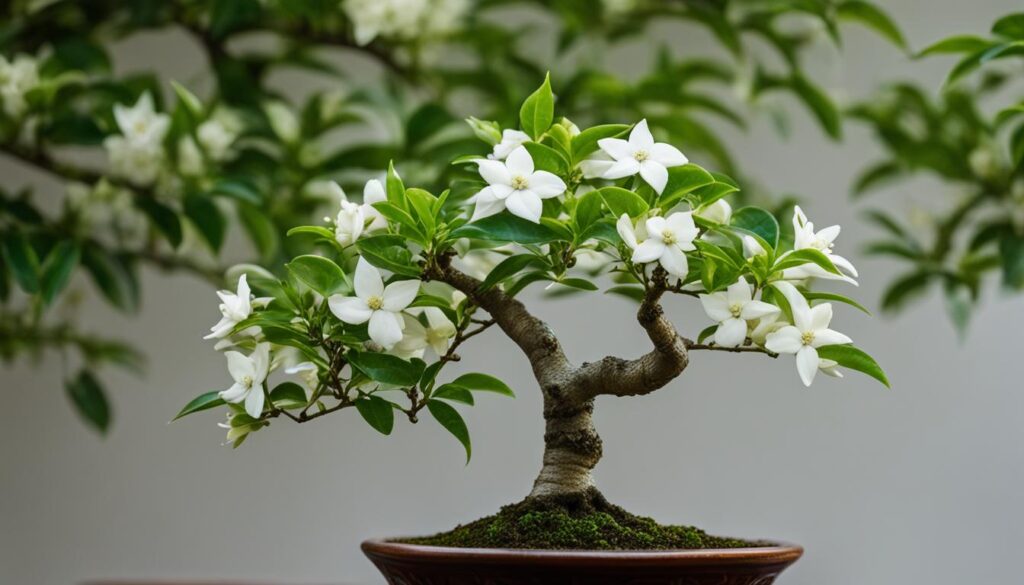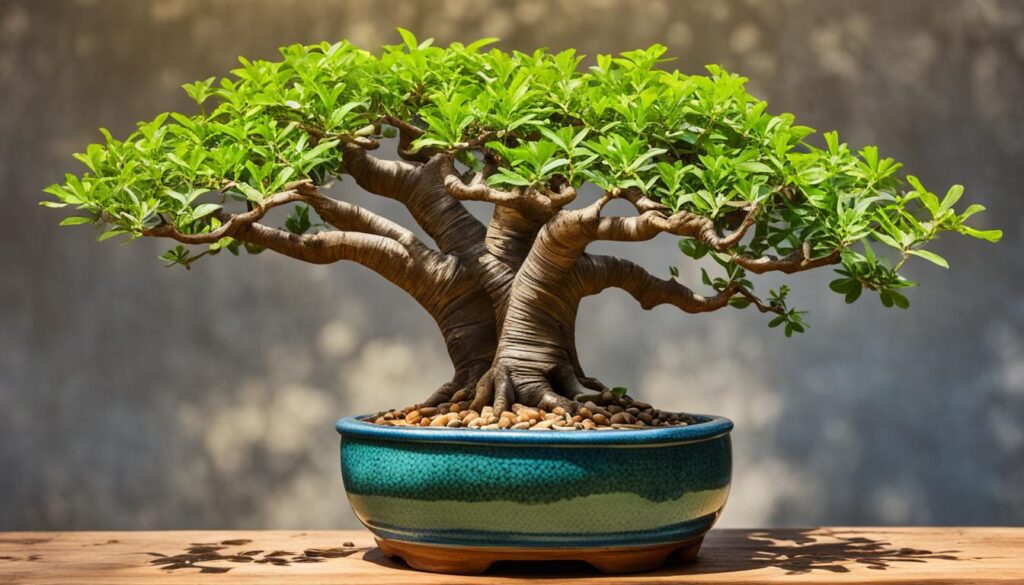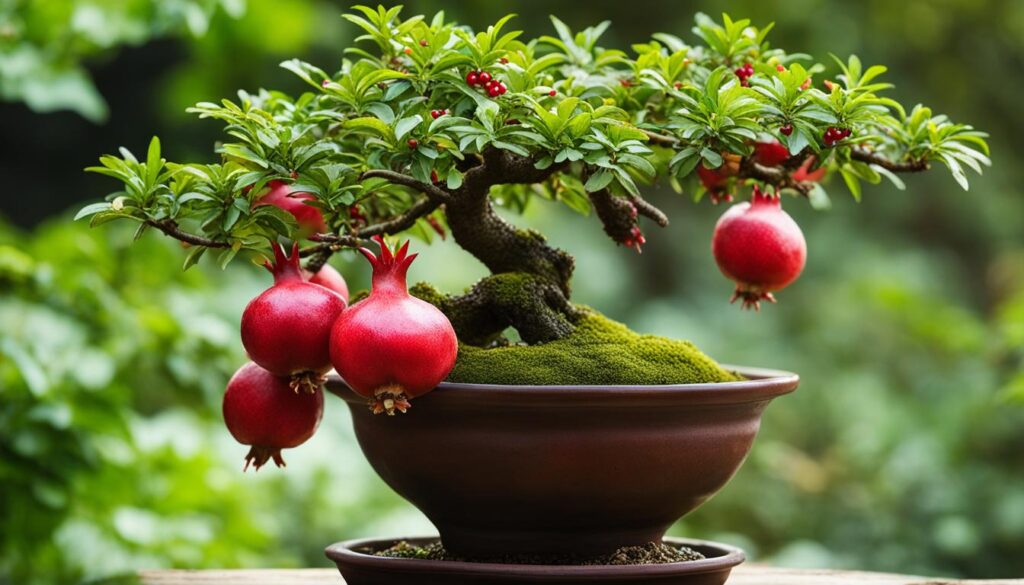Jasmine Bonsai (Jasminum nudiflorum) is a favorite among indoor bonsai enthusiasts for its delicate beauty and fragrance. This guide covers how to cultivate a healthy Jasmine Bonsai, from understanding its aesthetics to optimizing placement and watering practices.
By the end, you’ll be equipped to care for your Jasmine Bonsai and appreciate its beauty in your home or garden.
Key Takeaways
ToggleJasmine Bonsai Aesthetics
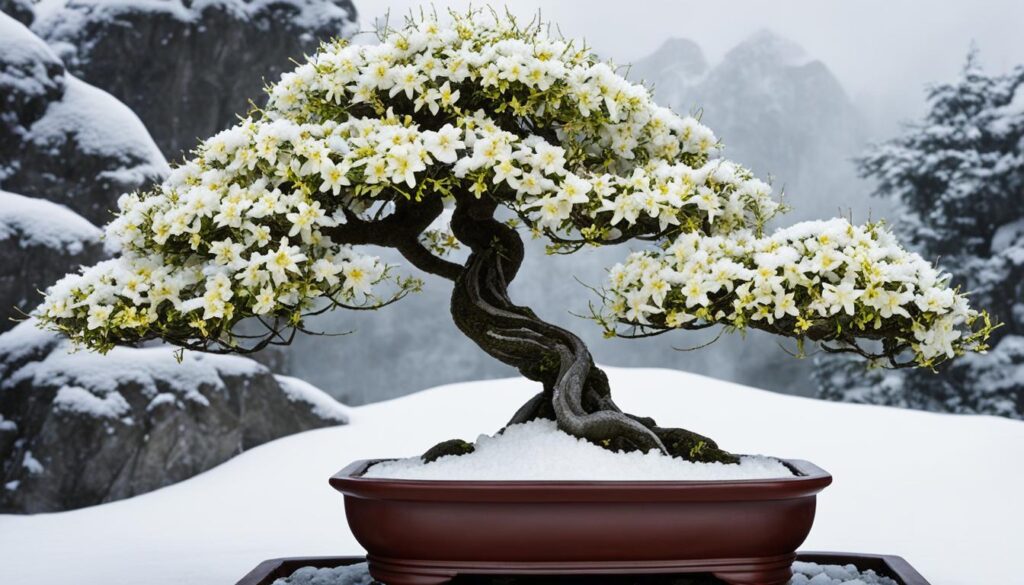
Aesthetics of Jasmine Bonsai
Winter Jasmine Bonsai (Jasminum nudiflorum) captivates with its ability to bloom during the winter, adding warmth with vibrant yellow flowers when most plants remain dormant. Its slender, green stems and intertwined branches enhance its graceful, balanced appearance, making it a valued addition to bonsai collections.
Fragrance Appeal
Beyond its beauty, Jasmine Bonsai offers a calming fragrance. The sweet, subtle scent from the blossoms fills the air, promoting a peaceful atmosphere.
Why Jasminum nudiflorum Stands Out
Winter Jasmine wins the admiration of bonsai enthusiasts for blooming in winter, creating a vivid contrast with the season’s stillness. Its visual appeal, combined with the soothing fragrance, makes it a sought-after species for those who appreciate both beauty and tranquility.
Optimal Placement for Growth
For healthy growth, place your Jasmine Bonsai in bright, indirect sunlight for 4-6 hours daily. Protect it from harsh winds, and ensure proper ventilation to avoid fungal issues.
Flowering Bonsai Trees >>>
Watering Techniques for a Healthy Indoor Jasmine Bonsai

Proper watering is vital for the health of your indoor jasmine bonsai. Understanding soil moisture balance and effective watering practices will help your bonsai thrive. Both overwatering and underwatering can harm your plant, so finding the right frequency is essential.
Soil Moisture Balance
Soil moisture balance is key to your jasmine bonsai’s watering needs. You must provide enough water for growth while preventing waterlogged soil. Excess moisture can cause root rot, while insufficient water can lead to wilting.
To assess soil moisture, use your finger or a moisture meter to check the soil. Insert your finger or the meter into the soil to the recommended depth. If the soil feels moist, do not water. If it feels dry, your bonsai needs water. Striking the right balance is crucial for optimal moisture.
Best Practices for Watering Frequency
Watering frequency depends on factors such as climate, humidity, pot size, and plant health. General guidelines include:
- Water more frequently during warmer months when the bonsai is actively growing.
- Reduce watering in colder months or during dormancy.
- Regularly observe the leaves and soil. Wilting leaves or excessively dry soil indicates a need for water.
- Avoid a strict schedule; adjust based on your jasmine bonsai’s condition.
Use a gentle watering can or misting spray bottle to avoid disturbing the soil or damaging roots. Water thoroughly until it drains from the pot’s holes to ensure proper hydration.
Each plant may require slight adjustments to watering techniques and frequency. Understanding soil moisture balance and best practices will help maintain a healthy plant.
The Art of Pruning Jasmine Bonsai
Pruning is essential for shaping and maintaining your jasmine bonsai. Mastering this skill promotes healthy growth and a balanced tree.
Timing is crucial; prune during the dormant season, typically late winter to early spring. This allows the tree to recover before active growth begins.
Start by removing dead, diseased, or damaged branches to maintain overall health. Use clean, sharp shears to make precise cuts, minimizing damage.
When shaping, maintain a natural form. Identify branches for shaping and trim them back, considering the tree’s balance and proportion. Regularly step back to evaluate the appearance.
Pinching is another technique that involves removing soft tips of new growth to encourage back-budding and promote a denser canopy. This helps maintain a compact appearance.
Throughout pruning, evaluate the tree’s balance and form. Take your time to ensure each cut enhances the bonsai’s natural beauty. With practice, you will develop a keen eye for shaping your bonsai.
Jasmine Bonsai Care Tips: Fertilizing and Humidity
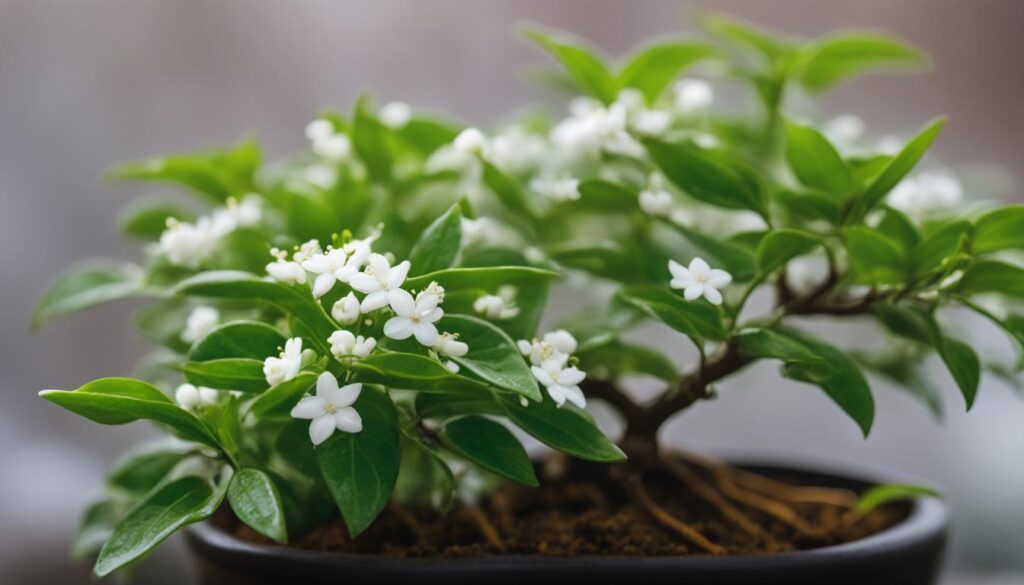
Fertilizing and maintaining proper humidity levels are essential for the care of your Jasmine Bonsai. In this section, we will provide you with valuable care tips to ensure the health and vitality of your bonsai tree.
“Fertilizing and maintaining proper humidity levels are essential for the care of your Jasmine Bonsai.”
Fertilizing Your Jasmine Bonsai
When it comes to fertilizing your Jasmine Bonsai, choosing the ideal type of fertilizer and determining the frequency of application are crucial factors. A balanced, slow-release fertilizer with a lower nitrogen content is recommended for Jasmine Bonsai to promote healthy growth and prevent excessive foliage.
- Choose a fertilizer specifically formulated for bonsai trees, ensuring it contains the necessary nutrients for optimal growth.
- Follow the manufacturer’s instructions for the correct dosage and application method.
- During the active growing season, typically from spring to early autumn, fertilize your plant every two to four weeks.
- Reduce the frequency of fertilization during the dormant season by applying fertilizer once every six to eight weeks.
Maintaining Suitable Humidity Levels
Proper humidity levels are vital for the health and well-being of your Jasmine Bonsai. Here are some strategies to help you maintain suitable moisture levels for your bonsai:
- Place your bonsai on a humidity tray filled with water and pebbles. The evaporation of water from the tray will increase the humidity around the bonsai.
- Mist the foliage of your Jasmine Bonsai regularly using a spray bottle filled with water. This will provide additional moisture to the leaves and maintain humidity.
- Avoid placing your bonsai near sources of dry heat, such as radiators or air vents, as they can dry out the foliage and decrease humidity levels.
By following these care tips, you can ensure that your Jasmine Bonsai receives the necessary nutrients and humidity for healthy growth and a thriving bonsai tree.
Repotting Strategies for Jasmine Bonsai
Repotting is a crucial aspect of bonsai care, ensuring the health and vitality of your Jasmine Bonsai. Knowing when and how to repot your bonsai is essential for its overall well-being. In this section, we will discuss the signs that indicate your bonsai needs a new home and provide you with a step-by-step guide to repotting.
Signs Your Bonsai Needs a New Home
Recognizing the signs that your Jasmine Bonsai requires repotting is vital for its continued growth and health. Here are some common indicators that your bonsai needs a new pot:
- The roots are circling the edge of the pot
- Excessive water runoff or poor drainage
- The soil is compacted and no longer retains moisture
- Stunted growth or lack of new foliage
If you notice any of these signs, it’s time to consider repotting your Jasmine Bonsai to provide it with a fresh and suitable environment.
Step-by-Step Guide to Repotting
Follow these step-by-step instructions to repot your Jasmine Bonsai:
- Prepare the new pot: Select a pot that is slightly larger than the current one, ensuring it has proper drainage holes.
- Remove the bonsai from its current pot: Gently tap the pot’s sides and bottom to loosen the root ball. Carefully lift the bonsai from the pot, being mindful not to damage the roots.
- Prune the roots: Trim away any dead or excessively long roots, promoting healthy growth and preventing rootbound conditions.
- Snip the wire: If your bonsai has wire, carefully cut it off to avoid causing damage during repotting.
- Add fresh soil: Fill the new pot with a suitable bonsai soil mix, ensuring proper drainage and aeration.
- Position your bonsai: Place the bonsai in the center of the new pot, ensuring it is at the desired angle and position.
- Backfill with soil: Gently fill the remaining space in the pot with soil, ensuring it is evenly distributed around the roots.
- Water your bonsai: Thoroughly water the bonsai to settle the soil and eliminate any air pockets.
- Place in a suitable location: After repotting, find a suitable spot for your Jasmine Bonsai, considering its light and temperature requirements.
Following this step-by-step guide will help ensure a successful repotting process for your Jasmine Bonsai, promoting its health and overall well-being.
Selecting the Best Soil for Jasmine Bonsai
The soil you choose for your Jasmine Bonsai is a critical factor in its overall health and growth. An ideal bonsai soil mix consists of specific components that provide proper drainage and aeration for your bonsai tree.
Components of an Ideal Bonsai Soil Mix
An ideal bonsai soil mix typically includes a combination of organic and inorganic materials. Organic components, such as peat moss or compost, provide nutrients and help retain moisture. Inorganic components, such as clay or gravel, promote drainage and prevent waterlogging. A good bonsai soil mix should strike a balance between water retention and drainage, allowing the roots to breathe while still providing adequate moisture.
Adjusting Soil Conditions for Different Climates
The soil requirements for Jasmine Bonsai can vary depending on the climate in which you live. In hot and arid climates, where the soil tends to dry out quickly, you may need to increase the proportion of organic materials in your soil mix to improve moisture retention. Conversely, in humid or rainy climates, where the soil can become waterlogged, adding more inorganic materials can enhance drainage. By adjusting the soil conditions according to your climate, you can create the optimal growing environment for your plant.
Remember to regularly check the moisture level of the soil to ensure it is neither too dry nor too wet. Over time, you may need to repot your plant and refresh the soil to maintain its health and vitality.
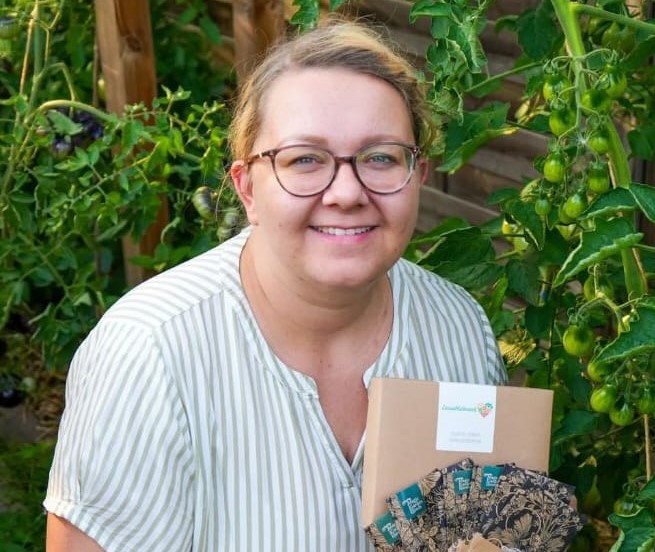
Karen Phillips, Bonsai expert and blogger. Read more about me here

